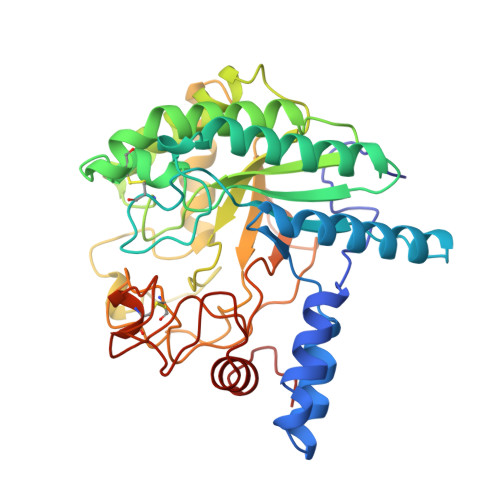The active site of Trichoderma reesei cellobiohydrolase II: the role of tyrosine 169.
Koivula, A., Reinikainen, T., Ruohonen, L., Valkeajarvi, A., Claeyssens, M., Teleman, O., Kleywegt, G.J., Szardenings, M., Rouvinen, J., Jones, T.A., Teeri, T.T.(1996) Protein Eng 9: 691-699
- PubMed: 8875646
- DOI: https://doi.org/10.1093/protein/9.8.691
- Primary Citation of Related Structures:
1CB2 - PubMed Abstract:
Trichoderma reesei cellobiohydrolase II (CBHII) is an exoglucanase cleaving primarily cellobiose units from the non-reducing end of cellulose chains. The beta-1,4 glycosidic bond is cleaved by acid catalysis with an aspartic acid, D221, as the likely proton donor, and another aspartate, D175, probably ensuring its protonation and stabilizing charged reaction intermediates. The catalytic base has not yet been identified experimentally. The refined crystal structure of CBHII also shows a tyrosine residue, Y169, located close enough to the scissile bond to be involved in catalysis. The role of this residue has been studied by introducing a mutation Y169F, and analysing the kinetic and binding behavior of the mutated CBHII. The crystal structure of the mutated enzyme was determined to 2.0 A resolution showing no changes when compared with the structure of native CBHII. However, the association constants of the mutant enzyme for cellobiose and cellotriose are increased threefold and for 4-methylumbelliferyl cellobioside over 50-fold. The catalytic constants towards cellotriose and cellotetraose are four times lower for the mutant. These data suggest that Y169, on interacting with a glucose ring entering the second subsite in a narrow tunnel, helps to distort the glucose ring into a more reactive conformation. In addition, a change in the pH activity profile was observed. This indicates that Y169 may have a second role in the catalysis, namely to affect the protonation state of the active site carboxylates, D175 and D221.
Organizational Affiliation:
VTT Biotechnology and Food Research, Espoo, Finland.
















